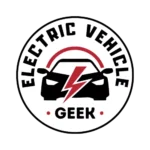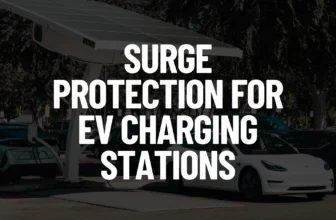Shunt trip breakers for EV charging installations ensure the safety, reliability, and control of EV charging systems, when activated, a shunt release quickly engages the circuit breaker mechanism to disconnect power to the EV charging station. the function of a dedicated EV charging circuit breaker and a shunt trip accessory are combined in a shunt trip breaker for EV charging.
Installing a shunt trip breaker in your EV charging system will improve the security of your electrical system by either manually or automatically shutting down the power supply to the EV charger circuit, in case of an emergency you can rest assured a shunt trip breaker will protect your EV charger and electric vehicle charging system from short circuits and electrical damage.
Shunt Trip Breaker Wiring Diagram
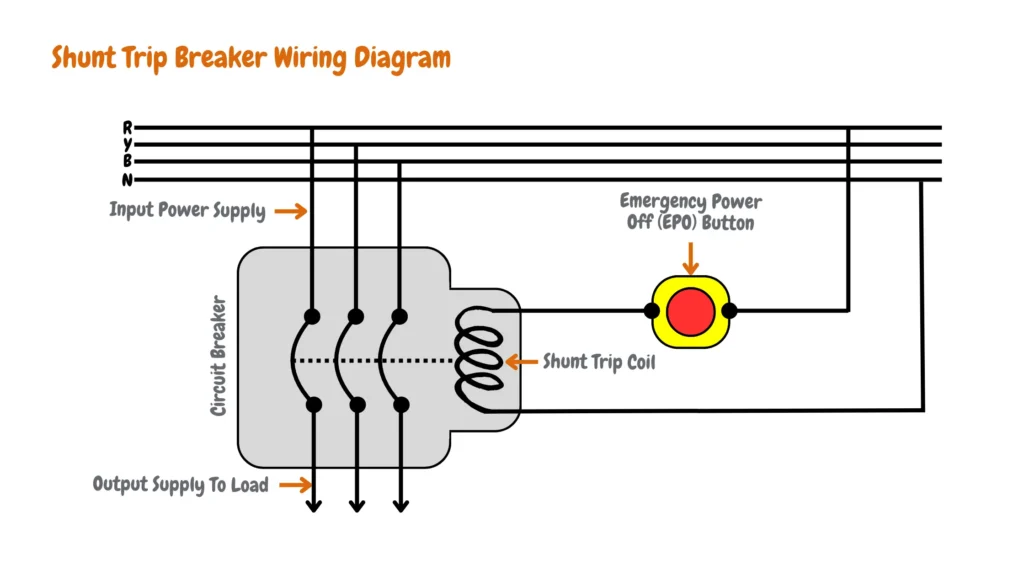
The shunt trip breaker wiring diagram above shows a straightforward connection between an Emergency Power Off (EPO) button and the shunt trip coil of a Molded Case Circuit Breaker (MCCB). The EPO button, usually situated in easily accessible areas, serves as a manual switch. When pressed, it sends a signal to the shunt trip coil, which causes the MCCB to trip, cutting power to the circuit.
The EPO button is normally open and closes the circuit when activated. By connecting the neutral wire of the power supply to one terminal of the shunt trip coil and the EPO button to the power supply and the shunt trip coil, the setup ensures that when the EPO button is pressed, power is supplied to the shunt trip coil, triggering the MCCB to trip.
Table of Contents
- Shunt Trip Breaker Wiring Diagram
- Best Shunt Trip Breakers for EV Charging Safety (20, 32,40 and 50 amps)
- Why Shunt Trip Breakers Are Essential for EV Charging
Best Shunt Trip Breakers for EV Charging Safety (20, 32,40 and 50 amps)
We recommend Shunt Trip Breakers Depending on the EV Charger Specifications:
Level 1 EV Charger (20 amps) Shunt Trip Breaker.
For Level 1 EV chargers drawing up to 20 amps, we recommend the Siemens Q12000S01 Shunt Trip Breaker because it’s one of the budget-friendly shunt trip breakers in the market that are long-lasting and heavy-duty for EV charging.
The Siemens Q12000S01 (20A, 120V shunt trip) is a suitable option for Level 1 EV charger installations. It offers combined load management and protection for the EV charger and vehicle. Notably, this breaker’s shunt trip functionality facilitates integration with renewable energy EV charging systems, enabling control over renewable energy load management strategies.
With the Siemens Q12000S01 20 amps circuit breaker with 120 V shunt trip, you can install a remote button that you can use to shut off power from EV chargers to minimize energy waste from phantom loads of the Level 1 EV charger (standby power or vampire power).
One thing that is a bummer with this shunt trip breaker is that it takes up space for 2 poles, unfortunately, most level 1 EV charger owners don’t want to upgrade the service panel for EV charging since they understand their 100 amps electrical panel can support a 20 amps single home EV charger installation, however, it might be clammed with home breakers leaving no room for a 2 poles spaced breaker.
Level 2 EV Charger (30 amps) Shunt Trip Breaker.
We recommend the Siemens Q23000S01 Shunt Trip Breaker for Level 2 EV chargers that require up to 32 amps, this means this breaker is safe for use on a 32 amps EV charger and a 30 amps EV charger.
The Siemens Q23000S01 Shunt Trip Breaker requires 3 poles space which makes it ideal for Level 2 EV charger subpanel installations, however, if you intend to install your EV charger on your main circuit breaker panel and you have the space of 3 poles you can use the Siemens Q23000S01 Shunt Trip Breaker which is of very high quality and can be used for remote control, renewable EV charging overcurrent protection and also remote complete shutt off power to EV charging.
Apart from its large space requirements, this is the perfect shunt trip breaker for 30 and 32 amps Level 2 EV chargers.
Level 2 EV Charger (40 amps) Shunt Trip Breaker
We also recommend a Siemens shunt trip breaker for 40 amps Level 2 EV chargers, specifically the Siemens Q24000S01 Shunt Trip Breaker, a Level 2 EV charger with 40 amps rating charges slowly, and for this reason, you will require a heavy-duty shunt trip breaker with best in the market thermal monitoring capabilities and that’s where the Siemens Q24000S01 Shunt Trip Breaker comes in …
The Siemens Q24000S01 Shunt Trip Breaker requires space for 3 poles meaning it’s best if you intend to install the shunt trip breaker on a big-sized electrical panel preferably a dedicated EV charger subpanel.
Level 2 EV Charger (50 amps) Shunt Trip Breaker
For 48 amps and 50 amps Level 2 EV chargers, we recommend the Siemens Q25000S01 Shunt Trip Breaker, The breaker is easy to install (just plug and play), especially for homeowners looking for a quick plug-and-play switch from their dedicated Level 2 EV charger circuit breaker to a shunt trip breaker for upgraded safety.
You can install an emergency power off (EPO) button to cut off power completely from the EV charger with the Siemens Q25000S01 shunt trip breaker, at this rating, a 50 amps Level 2 EV charger is a smart EV charger that uses power for its smart EV charging features even when not in use, you can install the Siemens Q25000S01 Shunt Trip Breaker to supply power to the EV charger and save on power bills from phantom loads of smart Level 2 EV charger.
Why Shunt Trip Breakers Are Essential for EV Charging
Shunt trip breakers provide a critical fail-safe mechanism in EV charging by enabling remote or manual disconnection and enhanced power management. They mitigate risks associated with high-current EV charging.
Some of the reasons why we recommend the integration of a shunt trip breaker into your EV charging setup include:
EV Charging Integration with Smart Grids and renewable energy EV charging systems
Shunt trip breakers can be integrated into smart grid systems and renewable energy EV charging systems, enabling advanced functionalities such as demand response, EV charging load management, and billing based on electricity usage. This enhances the efficiency and reliability of EV charging infrastructure, especially in scenarios where multiple charging stations are deployed in a network.
The diagram below shows a shunt trip breaker wiring diagram of an EV charger integrated with smart grids and energy EV charging systems.
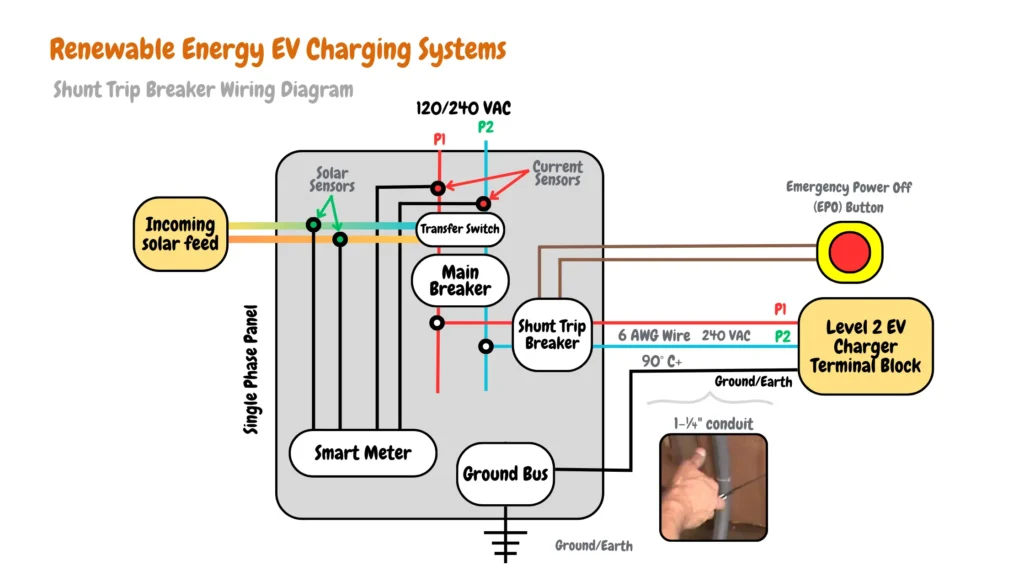
The shunt trip breaker is connected to an emergency power off (EPO) button, and the system allows complete shutdown of the EV charging system when either the transfer switch is allowing renewable EV charging or Grid EV charging, giving the EV owner a safety net regardless of the energy source.
EV Charging Emergency Shutdown
They can be used to quickly disconnect power to the EV charging station in case of emergencies, such as a malfunction or an accident involving the vehicle or the charging equipment. This helps ensure the safety of both the electric vehicle and any nearby personnel.
For homeowners with renewable energy systems installed such as power generators, and solar home EV charging systems that can’t handle the power voltage required for EV charging they can install a shunt trip breaker in their renewable home energy system to shut down renewable energy power flowing to the EV charger system.
To install a shunt trip breaker for emergency shutdown, you can replace the dedicated breaker of the EV charger with a shunt trip breaker of the same amperage, this will allow you to add an Emergency Power Off (EPO) button to shut off the current to the electric vehicle charger as shown in the EV charging emergency shutdown shunt trip breaker wiring diagram below:
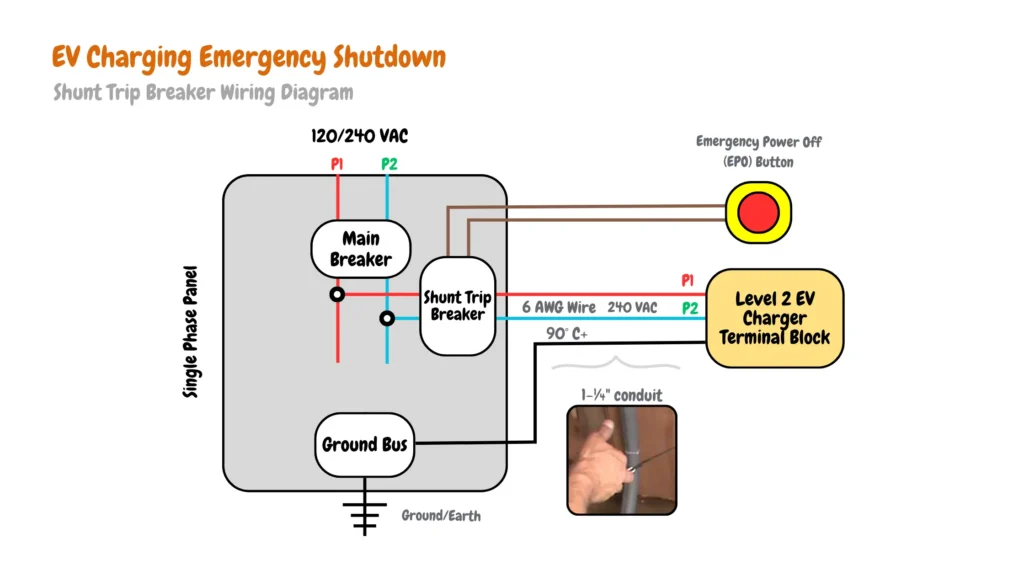
EV Charging Overcurrent Protection
Shunt trip breakers offer protection against overcurrent events, which can occur due to faults in the charging system or fluctuations in the power supply, and it’s quite useful for low amperage EV charging installations such as this 20 amps level 1 EV charger installation, as shown in the 20 amps hardwired EV charger installation below;

By tripping the 20 breakers during overcurrent events, shunt trip accessories prevent damage to the EV charging equipment and reduce the risk of fire or electrical hazards.
Although the EV charger and electric vehicle charging systems contain their thermal overload protection mechanisms, a shunt trip breaker can monitor and act faster to disconnect power if it rises above the trip point protecting your EV charger and electric vehicle from excessive current.
For secure Plug-in Level 1 and Level 2 EV charging installations, consider integrating a shunt trip breaker with your NEMA receptacle. This offers superior overcurrent protection against mismatched charging systems. A shunt trip breaker disconnects the circuit if a high-current charger exceeds the NEMA receptacle’s capacity or the circuit’s capacity, preventing overheating, equipment damage, and potential fires.
Level 1 EV Charger Installation Overcurrent Protection.
While convenient, Level 1 EV chargers (120V, 20A) are susceptible to overcurrent from mismatched loads. Common culprits include high-power electric cooktops, water heaters, and air conditioners. Industrial equipment like welders, large compressors, and ovens further exacerbate this risk. These loads exceed the 20A capacity of the NEMA 5-15 receptacle and circuit, potentially damaging electrical components and posing fire hazards.
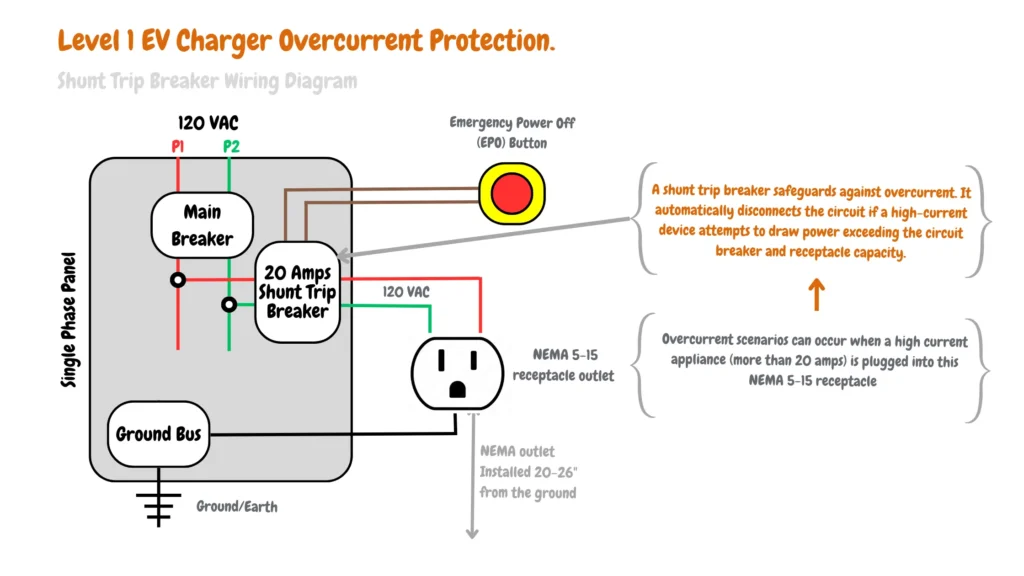
The above shunt trip breaker integration in Level 1 EV charging (Wiring Diagram) depicts a shunt trip breaker (20A) installed in a Level 1 EV charger setup. This safeguards against overcurrent caused by exceeding the circuit’s capacity. It automatically disconnects the circuit if a high-current appliance attempts to connect to the NEMA 5-15 receptacle. This includes scenarios where a mismatched EV charger with a higher current rating (more than 20amps) is plugged in, or even high-power appliances (more than 20 amps) accidentally plugged into the NEMA 5-15 receptacle outlet above with a current rating of 20 amps.
Level 2 EV Charger Overcurrent Protection.
Level 2 EV charger amperage varies (15-80A), impacting charging speed. This translates to circuit requirements (not needs) ranging from 20A to 80A depending on the specific charger model.
The provided diagram depicts a Level 2 EV charger wiring diagram compatible with 32A Level 2 EV chargers. In residences with high overall electrical demand, limiting (not limited to) the EV charging circuit to 50A via a suitable breaker may be prudent.
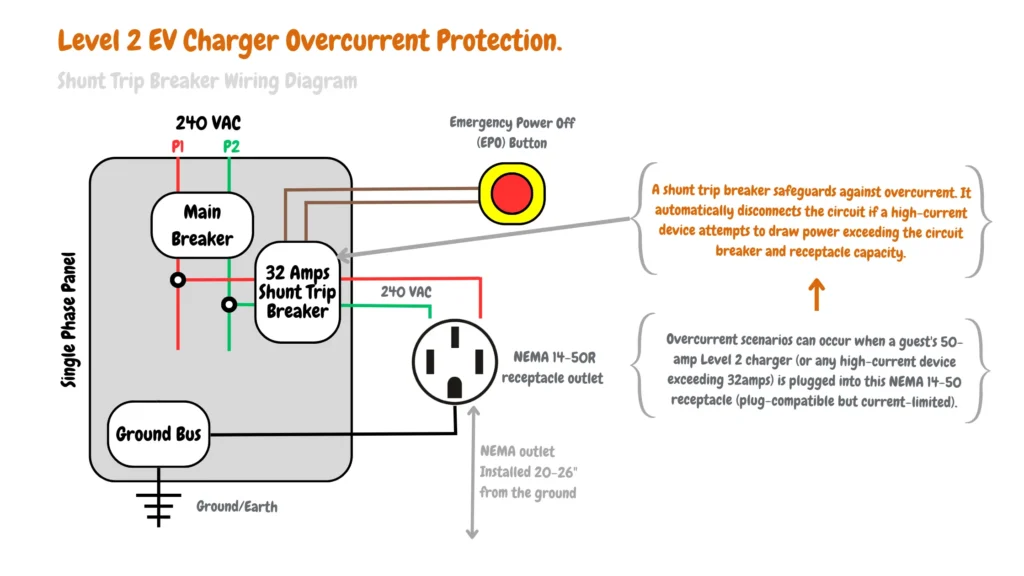
Overcurrent scenarios can occur when a guest’s 50-amp Level 2 charger is plugged into the above NEMA 14-50 receptacle (plug-compatible but current-limited). While the receptacle can physically accept the plug, the existing circuit breaker might not be rated for the higher current draw. This mismatch can lead to overcurrent and safety hazards.
As depicted in the Level 2 EV charger wiring diagram, a shunt trip breaker safeguards against overcurrent. It automatically disconnects the circuit if a high-current device attempts to draw power exceeding the circuit breaker and receptacle capacity. This protects your electrical system, EV charger, and vehicle from potential damage caused by circuit overload.
Overcurrent Protection for Limited Renewable Energy EV Charging
If your renewable energy EV charging system can’t sustain the high current draw of a high-current EV charger, a shunt trip breaker will prevent circuit overload by automatically disconnecting if a mismatched charger is plugged in. This protects your electrical infrastructure, renewable energy EV charging system, EV charger, and EV from potential damage.

The diagram above shows a low energy producing renewable energy EV charging system (such as solar) that supports EV charging with a low amperage plug-in EV charger with low amperage (32 amps) Level 2 EV charger, if a high current rating Level 2 EV charger (50 amps) is connected to the above system the shunt trip breaker will disconnect the power to the EV charger to prevent circuit overload of the renewable energy EV charging system that can damage renewable energy system equipment such as inverters, circuit breakers, wiring, EV charger, electrical vehicle charging system, etc due to overcurrent issues.
Overcurrent Protection in EV Charging with Low-Amp Service Panels
Shunt trip breakers offer a valuable overcurrent protection solution for both Level 1 and Level 2 EV charging, particularly when your home has limited 100 amps electrical EV charging main panels or 100 amps EV charging subpanels and you haven’t upgraded your EV charging system to a 200 amps EV charging panel.

The diagram above depicts a residence with a limited capacity service panel (100A) feeding a home electrical system (80A) and a Level 1 EV charger (20 amps). The NEMA 5-15 receptacle (20A) is compatible with Level 1 charging.
A shunt trip breaker safeguards the above circuit by interrupting power if a higher-current device (more than 20 amps) is plugged into the NEMA 5-15 receptacle. This prevents overloading the shared service panel, which could occur if it attempts to supply both the household load (80A) and a mismatched electrical load in the EV charger receptacle (exceeding 20A), exceeding the panel’s capacity (100A).
EV Charging Remote Control
In some EV charging setups, particularly in commercial or public charging stations, remote control capabilities provided by shunt trip breakers allow operators to monitor and manage the charging process more effectively. This includes initiating or terminating charging sessions remotely and troubleshooting issues without needing physical access to the electrical panel.
One way of EV charging remote control is by the use of a “smart switch” or “internet-connected switch” instead of an emergency power off (EPO) as shown in the EV charging remote control shunt trip breaker wiring diagram below that uses smart switches to initiate or terminate the charging sessions remotely.
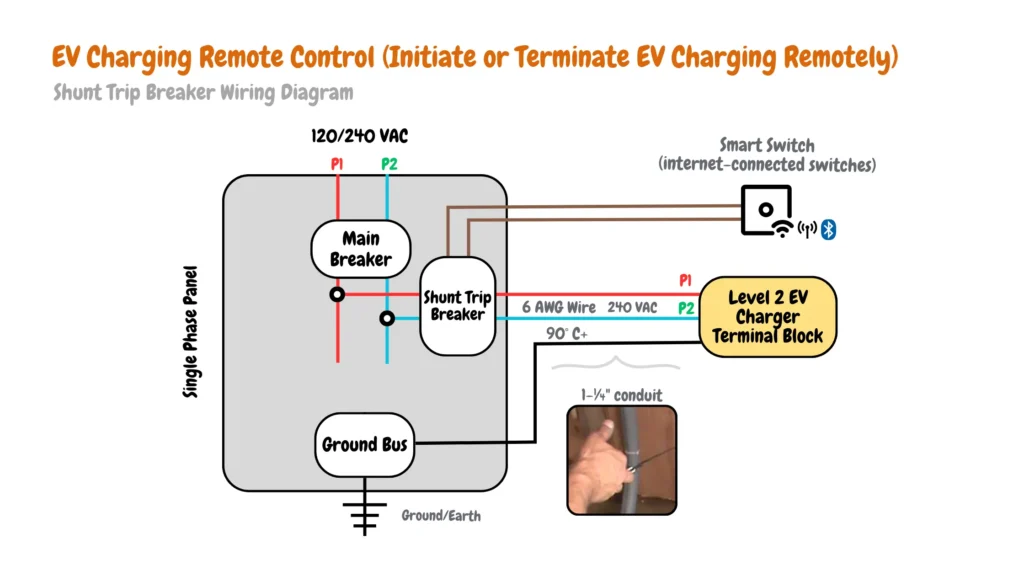
A smart switch with a shunt trip breaker allows remote shutoff of power to your EV charger via the internet. This is especially useful for scheduled charging when you’re away and forget to disconnect the charger. You can remotely cut power for added safety and prevent phantom energy drain. This remote control ensures your EV charger is only powered when needed, enhancing safety and minimizing energy waste from phantom loads of the EV charger (standby power or vampire power).
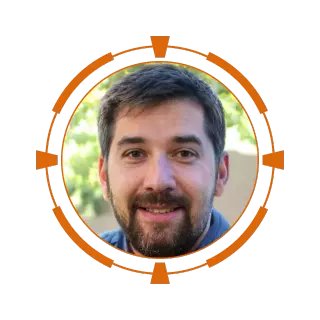
James Ndungu is a certified EV charger installer with over five years of experience in EVSE selection, permitting, and installation. He holds advanced credentials, including certification from the Electric Vehicle Infrastructure Training Program (EVITP) and specialized training in EV charging equipment and installation, as well as diplomas in EV Technology and Engineering Fundamentals of EVs. Since 2021, James has tested dozens of EV chargers and accessories, sharing expert insights into the latest EV charging technologies.
Last update on 2026-01-16 / Affiliate links / Images from Amazon Product Advertising API
